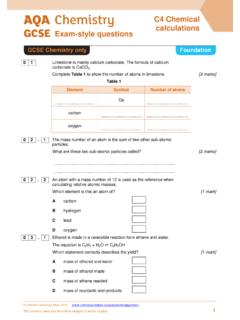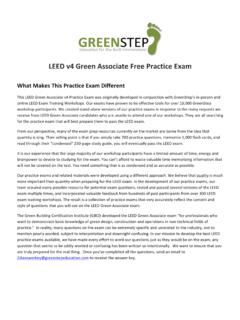Transcription of Our exams explained - filestore.aqa.org.uk
1 Our exams explainedGCSE science exams from summer 2018 Version September 2016 How we create exams that give students of all abilities the best opportunity to get the results they deserve. GCSE Combined Science: Trilogy (double award) GCSE Combined Science: Synergy (double award) GCSE Biology GCSE Chemistry GCSE PhysicsSee all our specimen question papers and mark schemes at Our exams explained GCSE science exams from summer 2018 3 Contents Exam structure 4 Introduction 4 Ramping and level of demand 5 Common questions between tiers 7 Working scientifically 7 Assessment objectives 8 Extended response and linked questions 8 Mathematical skills 8 Equations 9 Accessibility 9 Sample questions with commentaries 10 question scaffolding 10 Multiple choice questions 12 Link box 16 Sentence completion 18
2 Short answer 19 Calculations 22 Labelling and drawing diagrams 32 Graphs 36 Chemical equations 44 Extended response 47 Linking of ideas 54 Practical skills 60 4 Exam structure Introduction Our GCSE Science papers have been carefully designed to engage students so that they can show what they can do. The papers are deliberately flexible in terms of the mixture of question types and number of marks within each topic. This approach gives examiners the freedom to choose the best question style for the context and science content being assessed.
3 It is also in line with the regulatory requirements. The topics we re assessing are split across each paper so that you can prepare for examinations more easily. Each question assesses an assessment objective and in some cases more than one assessment objective. We use a consistent range of question types: Closed multiple-choice, link boxes, sentence completion, labelling diagrams. Open labelling/drawing diagrams, short answer, calculations, extended response. Our questions are structured: Within a whole question (eg question 01) there are several parts (eg , , and ) that link to a common theme/topic.
4 We ll scaffold questions more in Foundation Tier papers. There will be a higher proportion of multiple-choice and short answer questions in the Foundation Tier too. In Higher Tier papers there will be more marks for open and extended response questions. Our exams explained GCSE science exams from summer 2018 5 Ramping and level of demand Ramping means that a question gets progressively more difficult as you work through it. Questions for any topic area will be ramped in terms of demand within the question , as well as within the paper.
5 This allows all students a fair chance of gaining some marks on each topic area throughout the paper. Some questions will step up in demand gradually, others quite sharply. In addition the demand also increases steadily throughout the paper. We use the model above to structure the ramping of Foundation Tier and Higher Tier question papers. Both tiers start with confidence-building questions set at the lowest demand for the paper: Low for Foundation Tier; and Standard for Higher Tier. The middle of each paper introduces ramping of each question up to the next level of demand.
6 Within each question the demand increases, then the following question starts again at a lower demand. The end of the paper is where the students ability is stretched the most. In the Foundation Tier this means questions are set at standard demand (common with the Higher Tier). In the Higher Tier the latter questions continue to ramp, but at a much higher level. 6 Level of demand is determined by factors such as: concept, context, the number of marks and the command word(s) used. The number of marks assigned to each level of demand within each paper is not precise (within a range) due to the complexity of these factors.
7 Foundation Tier papers are made up of: low demand questions (aimed at grades 1 3) standard demand questions (aimed at grades 4 5). A greater proportion of questions will be low demand. Higher Tier papers are made up of: standard demand questions (aimed at grades 4 5) standard/high demand questions (aimed at grades 6 7) high demand questions (aimed at grades 8 9). Our exams explained GCSE science exams from summer 2018 7 Common questions between tiers We will have 30% of marks that are common between Foundation and Higher Tier papers.
8 This allows us to better align standards for grades 4 5. Common questions will be standard demand. Working scientifically Working scientifically is a fundamental part of learning science. It is the sum of all the activities that scientists do and is a fundamental part of learning about and learning through science. Students need to develop their working scientifically skills so that they can fully understand the scientific process. These skills fall broadly into four main strands: 1. the development of scientific thinking 2.
9 Experimental skills and strategies 3. analysis and evaluation 4. vocabulary, units, symbols and nomenclature. exams will include questions that assess all of these strands. So, students should expect to see questions that: require knowledge of how scientists know what they know directly assess practical and enquiry skills. indicates requirements set by the DfE and Ofqual. 8 Assessment objectives The exams will measure how students have achieved the following assessment objectives . AO1: Demonstrate knowledge and understanding of: 40% 1) scientific ideas 2) scientific techniques and procedures.
10 AO2: Apply knowledge and understanding of: 40% 1) scientific ideas 2) scientific enquiry, techniques and procedures. AO3: Analyse information and ideas to: 20% 1a) interpret 1b) evaluate 2a) make judgements 2b) draw conclusions 3a) develop experimental procedures 3b) improve experimental procedures. Extended response and linked questions Some questions will test students ability to link topics across different areas of the specification. These questions are more likely to require an extended response and are marked using a levels of response mark scheme.











